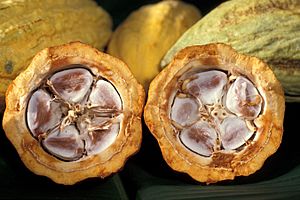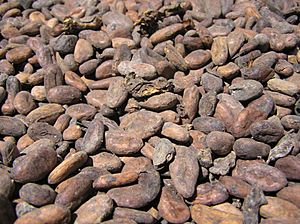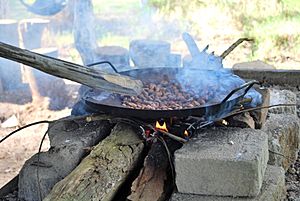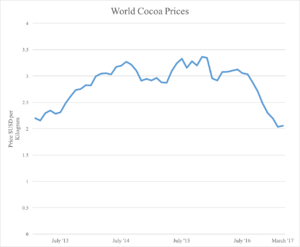Fair trade cocoa facts for kids
Fair trade cocoa is a special kind of cocoa. It comes from cocoa trees and is grown and sold in a way that helps farmers and their families earn a fair income. Companies that use fair trade cocoa show that they care about being fair to people, helping the economy, and protecting the environment.
Contents
Why Fair Trade Cocoa Started
Back in the 1990s, most of the world's cocoa came from small farms, especially in West Africa and Latin America. Farmers often didn't know how much their cocoa was really worth or where it ended up. Low prices and the need for expensive fertilizers made it hard for farmers. This sometimes led to serious problems like forced labor, including child labor, in some cocoa-growing countries.
To fix these problems, fair trade cocoa certification was created. The first fair trade cocoa product was a chocolate bar called Green & Black's Maya Gold Chocolate in 1994. It was certified by a group in the Netherlands called the Max Havelaar Foundation. This group later became part of Fairtrade International (FLO), which is a big non-profit organization that helps certify fair trade products around the world.
In 2002, another group called Fair Trade USA started certifying fair trade cocoa products sold in the United States. They later became separate from Fairtrade International in 2011.
Around 2001, people started learning more about forced labor in cocoa farming. News reports shared stories of children being trafficked to work on cocoa farms. Because of this, some leaders in the United States tried to make a law for a "slave-free" label on chocolate. The cocoa industry didn't want this, so they agreed to a voluntary plan instead. This plan, called the Harkin–Engel Protocol, meant chocolate makers promised by July 1, 2005, to make sure their cocoa was not produced using the worst forms of child labor.
However, a big study in 2016 found that about 2.1 million children in West Africa were still doing dangerous and hard work harvesting cocoa. The report also showed that many farmers in Ghana earned only about 84 cents a day, and farmers in Ivory Coast earned about 50 cents a day. This was much less than the amount needed to escape extreme poverty. Experts said that solving the problem of child labor would need a huge effort from governments, communities, and companies working together.
What Makes Cocoa Fair Trade?
Different organizations have slightly different rules for fair trade cocoa, but these are the main ideas:
- Fair Trade helps farmers work together in groups called cooperatives. This helps them get fair prices for their cocoa.
- Fair Trade groups regularly check cocoa farms to make sure there is no child labor. If they find problems, they act quickly to protect the children.
- Fair Trade encourages farming methods that are good for the environment. They do not allow dangerous chemicals or genetically modified crops.
- Fair Trade guarantees a minimum price for cocoa. This means farmers are paid enough to live on, even if the market price drops. Also, buyers often contribute extra money to the community. This money helps farmers improve their cocoa quality, build things like roads, train workers, get clean water, and even build health clinics and schools.
Fair Trade Cocoa in the United States
By 2010, there were 62 cocoa-growing groups in the US fair trade system. These groups were in countries like Bolivia, Côte d'Ivoire, Dominican Republic, Ecuador, Ghana, Panama, and Peru.
In 2010, the amount of fair trade cocoa products sold in the United States grew a lot, increasing by 67% from the year before. However, this was still a small part of all the cocoa products sold. Also, in the USA, a product could be called "Fair Trade Chocolate" even if only 11% of its cocoa was fair trade certified.
For a short time in 2010, the Kit Kat chocolate bar in the UK started using fair trade cocoa, but it later stopped.
How Fair Trade Helps Farmers and Communities
More Money for Farmers
Usually, farmers who grow cocoa beans get only a tiny part of the money from a chocolate bar. In Ghana and Ivory Coast, where most of the world's chocolate comes from, farmers might earn as little as 50 cents a day. Their income mostly depends on cocoa farming.
The price of cocoa can change a lot. For example, it was as low as $714 per ton in 2000 and as high as $3,775 per ton in 2011. Fair trade certification sets a minimum price that farmers must be paid. Farmers get either the market price or the fair trade minimum, whichever is higher. In 2011, Fairtrade International set the minimum price at $2000 per metric ton of cocoa. This minimum price gives farmers a steady income, helping them plan for the future and have a better life.
Also, the average age of cocoa farmers is getting older, around 50 years old. Young people often don't want to be farmers because the pay is so low. By increasing wages through fair trade, more young people might stay in farming. This helps make sure there will be enough chocolate in the future.
Since 1998, Fair Trade USA has helped companies using fair trade cocoa in the US provide over $220 million in extra income to cocoa farming communities.
Helping Communities Grow
Since 2002, fair trade cocoa companies certified by Fair Trade USA have given $1.25 million directly to fair trade cocoa cooperatives for community projects. These extra funds help communities get better healthcare and education, support women, and protect the environment. Most of these fair trade cocoa cooperatives are in West Africa and Latin America.
More Fairness for Women
Women often earn even less than men on cocoa farms, or sometimes nothing at all. In Ivory Coast, women do almost 70% of the farm work but receive only about 20% of the income. Also, only about 25% of women own the land they farm. This means women can't get loans to improve their farms or buy better equipment. Fair trade cocoa makes sure everyone is paid equally, no matter their gender. When women earn more, they can invest in their farms, which helps grow more and better cocoa. It also improves the lives of their children.
How Fair Trade Affects Politics
In Côte d'Ivoire, much of the country's money and jobs come from cocoa. In the past, money from the cocoa trade even helped fund armed conflicts. After the 2010 presidential election, there was a disagreement over who won. The internationally recognized winner called for a ban on cocoa exports to stop the other side from getting money. The European Union supported this ban. Cocoa farmers kept harvesting their beans, but most were stored and not exported. Some cocoa was secretly moved through nearby countries.
How Fair Trade Helps the Environment
Studies show that much of the cocoa farming in Ghana, a big cocoa producer, is not good for the environment. It can harm the ozone layer, pollute water and soil with pesticides, and cause air pollution.
To get fair trade certified, cocoa companies must follow fair trade environmental rules. They have to check how their farming affects the environment, make plans to reduce harm, and make sure those plans are followed. While rules vary, they all include using water wisely, rotating crops, reducing carbon pollution, protecting different types of plants and animals, not using genetically modified crops, safely using only approved pesticides, and properly getting rid of dangerous waste.
The pesticides used in regular cocoa farming can be very harmful. For example, Lindane, a common pesticide, can irritate the lungs and cause seizures and vomiting if inhaled. Because farmers often live in poverty, they might not have proper protective gear when using these chemicals. This means they are exposed to dangerous chemicals for a long time, which can cause serious health problems. By earning more money through fair trade, farmers can buy and use proper protective gear. Many fair trade certifiers also encourage farming methods that are good for the environment and safer for workers.
How Companies Respond to Fair Trade
The global chocolate industry was worth about $98 billion by the end of 2016. In 2015, the United States alone had a $22 billion chocolate market. This means the US has a big chance to help cocoa farmers around the world. Theo Chocolate, started in 2006, was the first company in the US to be certified as bean-to-bar, fair trade, and organic. Other companies like Dandelion Chocolate and Askinose Chocolate have also joined.
Hershey
People who support fair trade cocoa have asked Hershey, a very large chocolate maker in the United States, to start using fair trade cocoa. As of 2012, these efforts had not been very successful.
Ben & Jerry's
The American ice cream company Ben & Jerry's promised to use fair trade certified cocoa in all its ice creams by 2013.
Endangered Species Chocolate
Endangered Species Chocolate, a chocolate company in Indiana, was fair trade certified until 2006. After that, they decided to use the money they would have spent on certification to directly help the farmers in the Conacado Co-op, where they still get their cocoa. They promise that their cocoa farmers in this co-op receive a fair wage.
One thing to think about is that companies pay money to certifying groups to get the fair trade label, and this money doesn't go directly to farmers. On the other hand, if a company says it follows fair trade rules but isn't certified, it might not actually be doing so. This could lead to companies saying they are fair trade, charging more, but not really paying farmers higher wages.
Cadbury
Cadbury announced in 2009 that its Cadbury Dairy Milk chocolate in the UK would become fair trade. This change then spread to other countries like Australia, New Zealand, Ireland, Canada, India, and South Africa. Cadbury also put the Fairtrade certification mark on its chocolate bars.
In 2017, Cadbury stopped using the Fairtrade mark for its main certification. Instead, with its parent company Mondelez, it launched its own program called Cocoa Life. Cocoa Life is a $400 million program that aimed to reach 200,000 fair trade cocoa farmers by 2022. Some people were worried when Cadbury stopped using the Fairtrade mark, thinking it might confuse customers. However, both Cadbury and the Fairtrade Foundation explained that they still worked together.
Child Labor and Fair Trade
Because farmers in regular chocolate growing often earn very little, they sometimes can't afford to hire enough adult workers. This leads to children being used for labor. In 2009, over 109,000 children in Ivory Coast were involved in child labor. This meant many children were not going to school. UNICEF found that from 2008 to 2012, only about 67% of boys and 55% of girls were enrolled in primary school.
With fair trade practices, child labor is not allowed, and farmers are paid a fair wage. This allows more children to go to school and get an education. Getting an education is a big step towards breaking the cycle of poverty.
Experts agree that the best way to stop abusive child labor in cocoa farming is to pay farmers a price that allows them to hire adult workers. They also say farmers need to work together and know the true world price of cocoa so they can bargain better.
Global Exchange, a human rights group, believes that fair trade cocoa is a way to end child labor in cocoa production. In 2001, the US cocoa industry set a goal to end abusive child labor by 2005. However, by 2012, this goal had not been met. Global Exchange believes that the industry will adopt fair trade certification when more people choose to buy fair trade chocolate.
Child Labor: 2015–2018
A study in 2016 found that about 2.1 million children in West Africa were still doing dangerous and hard work harvesting cocoa. The report said it would be very difficult to improve the situation. It noted that the average farmer in Ghana earned only 84 cents a day, and in Ivory Coast, only 50 cents a day. This was far below the amount needed to escape extreme poverty.
Sona Ebai, a former leader of cocoa-producing countries, said that ending child labor was a huge job. He felt that chocolate companies' efforts were not enough. He said, "Best-case scenario, we're only doing 10% of what's needed. Getting that other 90% won't be easy." He believed that governments, communities, and businesses all needed to work together.
In April 2018, a report called the Cocoa Barometer 2018 looked at the $100-billion cocoa industry. It stated that "Not a single company or government is anywhere near reaching the sectorwide objective of the elimination of child labour." It also said they were not even close to their own goals of reducing child labor by 70% by 2020.
Later that year, another report mentioned that systems to monitor and fix child labor problems were helpful. However, they were only reaching less than 20% of the over two million children affected.
See also





